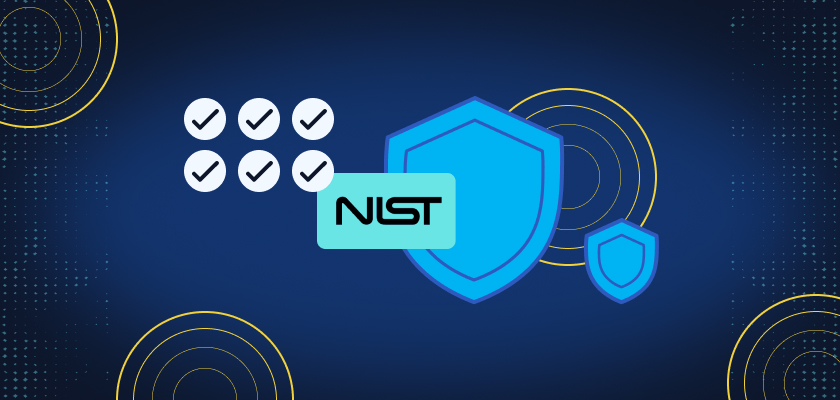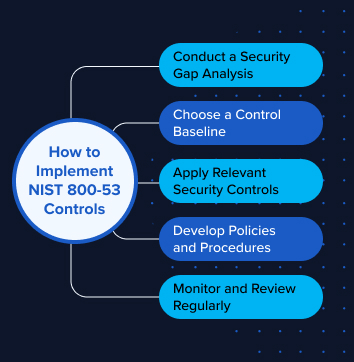
NIST Special Publication 800-53 is a foundational cybersecurity framework that provides a comprehensive catalog of security and privacy controls for federal information systems and organizations.
This framework aims to secure IT systems through structured risk management practices, data protection, and compliance requirements. For MSPs and MSSPs, adopting NIST 800-53 offers a standardized approach to reducing risks, delivering consistent security services, and meeting regulatory demands across diverse client environments.
What Is NIST 800-53?
NIST 800-53 Definition: A catalog of security and privacy controls designed to enhance the protection of federal information systems. Its primary goal is to provide a standardized, risk-based approach to managing cybersecurity and privacy, ensuring that organizations can effectively address vulnerabilities while maintaining compliance.
Although initially developed for U.S. government agencies, many private organizations have adopted NIST 800-53 to strengthen their cybersecurity posture and streamline operations.
Why Is NIST 800-53 Important for MSPs and MSSPs?
NIST 800-53 provides a robust framework that addresses multiple facets of cybersecurity, making it particularly beneficial for MSPs and MSSPs:
- Comprehensive Coverage: The framework covers critical areas like access control, incident response, and system integrity, enabling service providers to deliver holistic security solutions.
- Compliance-Ready: NIST 800-53 aligns with regulatory frameworks like HIPAA, PCI-DSS, and CMMC, simplifying the path to compliance for service providers and their clients.
- Risk Reduction: Its risk-based controls help identify and mitigate vulnerabilities, reducing the likelihood of cyberattacks and data breaches.
- Enhanced Client Trust: Following NIST 800-53 demonstrates a commitment to industry-leading security standards, fostering trust among clients and stakeholders.
Key Components of NIST 800-53
Control Families:
NIST 800-53 organizes its controls into 20 families, each addressing specific cybersecurity areas. Examples include:
- Access Control (AC): Manages user permissions and data access.
- Incident Response (IR): Prepares for and mitigates security incidents.
- Risk Assessment (RA): Evaluates and addresses potential security risks.
Review the NIST Control Families: A Comprehensive Guide for the breakdown of all 20 controls.
Security and Privacy Controls:
The NIST 800-53 framework provides an extensive set of technical, administrative, and physical controls designed to mitigate a wide range of security and privacy risks.
These controls are categorized into families that address critical cybersecurity functions, such as access control, incident response, and system integrity. In addition to cybersecurity, NIST 800-53 emphasizes privacy by incorporating measures to protect personal data, reduce data misuse, and ensure compliance with applicable regulations.
Examples of Security Controls:
- Technical Controls: Encryption, firewalls, and intrusion detection systems.
- Administrative Controls: Policies for user authentication, incident response plans, and access reviews.
- Physical Controls: Security for data centers, including surveillance systems and restricted access.
By addressing both cybersecurity and privacy, the framework ensures comprehensive protection for organizations managing sensitive information in today’s digital landscape.
Control Baselines:
NIST 800-53 offers three control baselines—Low, Moderate, and High—allowing organizations to tailor their security measures based on risk levels and operational needs.
| Baseline | Description | Examples |
| Low Baseline | For systems handling less sensitive information, where the impact of a breach would be minimal. | Public-facing websites or non-critical databases. |
| Moderate Baseline | For systems containing more sensitive information or supporting essential operations. | Systems managing proprietary business information or internal operational data. |
| High Baseline | For systems where the impact of a breach would be severe, potentially affecting national security or public safety. | Systems containing Controlled Unclassified Information (CUI) or mission-critical infrastructure. |
Risk Management Framework (RMF):
Integrated into NIST 800-53, the RMF provides a structured, repeatable process for managing security risks throughout the system lifecycle.
The RMF ensures organizations maintain a proactive approach to risk management through six key steps. Learn more about NIST Risk Management Framework here.
Privacy Controls:
Updated significantly in Revision 5, NIST 800-53 includes enhanced privacy controls designed to align with global privacy regulations such as GDPR (General Data Protection Regulation) and CCPA (California Consumer Privacy Act).
These controls address critical areas such as:
- Consent Management: Ensuring individuals are informed about how their data is collected and used.
- Data Minimization: Limiting the collection and storage of personal data to only what is necessary for business operations.
- Data Retention and Disposal: Implementing policies for securely managing data throughout its lifecycle, including timely disposal of obsolete records.
By integrating privacy considerations into the overall framework, NIST 800-53 helps organizations protect sensitive personal data while demonstrating compliance with evolving privacy laws.
How to Implement NIST 800-53 Controls
Implementing NIST 800-53 controls involves a structured approach to ensure effective risk management and compliance:

- Conduct a Security Gap Analysis: Assess your current security posture to identify areas that fall short of NIST 800-53 requirements.
- Choose a Control Baseline: Select the appropriate baseline (Low, Moderate, or High) based on your client’s risk level and business requirements.
- Apply Relevant Security Controls: Implement controls across categories like access management, incident response, and system integrity.
- Develop Policies and Procedures: Establish clear policies for data protection, user management, and compliance reporting.
- Monitor and Review Regularly: Continuously evaluate the effectiveness of controls using automated tools and periodic audits.
Best Practices for Managing NIST 800-53
Effectively managing NIST 800-53 controls requires a proactive and organized approach. By following best practices, MSPs and MSSPs can ensure consistent implementation, maintain compliance, and address emerging threats efficiently. Consider the following strategies:
- Start with a Security Framework Assessment: Conduct an initial assessment to determine your compliance baseline and identify gaps.
- Automate Compliance Tasks: Use tools to automate policy enforcement, reporting, and incident tracking, saving time and resources.
- Align with Other Standards: Map NIST 800-53 controls to frameworks like ISO 27001 or CIS Controls to create a comprehensive security strategy.
- Develop an Incident Response Plan: Ensure your incident response plan aligns with NIST guidelines and is regularly tested for effectiveness.
- Perform Regular Audits: Conduct both internal and third-party audits to verify compliance and identify areas for improvement.
Simplify NIST 800-53 Implementation with Cynomi
Implementing and managing NIST 800-53 controls can be complex, but Cynomi’s platform simplifies the process. By leveraging automation and tailored compliance tools, MSPs and MSSPs can streamline operations and focus on delivering exceptional service.
- Automated Security Management: Cynomi’s platform automates key compliance tasks, including risk assessments, policy creation, and reporting, simplifying the implementation of NIST 800-53.
- Custom Control Mapping: Cynomi enables you to map NIST 800-53 controls to your clients’ unique business needs and other frameworks they may need to comply with, ensuring seamless integration.
- Stay Audit-Ready: Generate real-time compliance reports to demonstrate adherence to NIST 800-53 requirements during audits.
Book a demo with Cynomi today to see how we can help you simplify NIST 800-53 implementation and compliance management.
Achieve Comprehensive Security with NIST 800-53
NIST 800-53 is a critical framework for MSPs and MSSPs looking to deliver robust cybersecurity services. By implementing its comprehensive controls, service providers can secure IT systems, reduce risks, and ensure compliance across diverse client environments.
Adopting this framework strengthens your cybersecurity posture, fosters client trust, and positions your services as industry-leading.
Step-by-Step Guide to NIST Compliance for Service Providers
Simplify NIST compliance with a step-by-step roadmap, actionable best practices, and tools to help your MSP or MSSP scale services efficiently and securely.
Frequently Asked Questions About NIST 800-53
NIST 800-53 is a catalog of security and privacy controls designed for federal information systems but widely adopted by private organizations to enhance cybersecurity.
<!– wp:cy/composite-cta {“name”:”cy/composite-cta”,”data”:{“field_67a48c39723da”:{“field_67a48c5b723db”:””,”field_67a48c6d723dc”:”Step-by-Step Guide to NIST Compliance for Service Providers”,”field_67a48c84723dd”:”Simplify NIST compliance with a step-by-step roadmap, actionable best practices, and tools to help your MSP or MSSP scale services efficiently and securely.”,”field_67a49410723e1″:”1″,”field_67a48c8d723de”:{“title”:”Download”,”url”:”https://cynomi.com/guide-to-nist-compliance-for-service-providers/”,”target”:”_blank”}}},”mode”:”edit”} /–>It provides a standardized approach to implementing risk-based security controls, ensuring consistent protection and compliance for clients.
Key components include control families, security and privacy controls, baselines, and the Risk Management Framework (RMF).
NIST 800-53 provides detailed technical and administrative controls, while NIST CSF is a high-level framework focusing on risk management.
The latest revision, Revision 5, includes updates like privacy controls and improved guidance on implementing security measures.